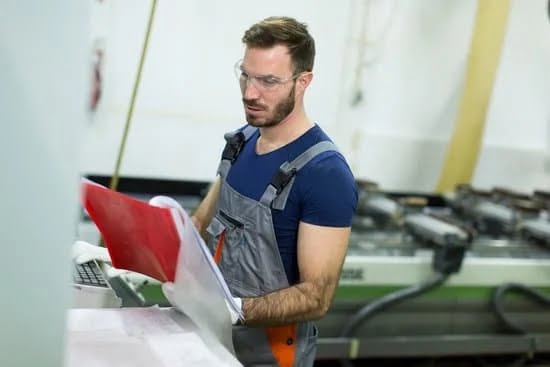Are CNC machines cheating? Is pocket hole joinery real woodworking? These are questions that have sparked a heated debate in the woodworking community. As modern technology continues to revolutionize the industry, traditionalists and proponents of new methods find themselves at odds over what constitutes real craftsmanship in woodworking.
CNC (computer numerical control) machines have transformed the way woodworkers approach their craft. These computer-controlled devices can accurately carve, cut, and shape wood with precision and efficiency. Some purists argue that relying on CNC machines is a form of cheating, as it diminishes the skill and artistry of traditional woodworking techniques.
On the other hand, pocket hole joinery has been hailed as a simple and effective method for joining wood pieces together. However, its detractors argue that this technique lacks the intricacy and complexity required for true woodworking mastery. The controversy surrounding these issues has brought to light questions about what it means to be a real woodworking artisan in the modern age.
The intersection of tradition and innovation in woodworking has sparked an ongoing debate within the community. As technology continues to advance, woodworkers must grapple with how to embrace these new tools while preserving the integrity of their craft. It is essential to understand both perspectives and explore how CNC machines can complement traditional techniques rather than overshadow them.
The Controversy
The use of CNC (Computer Numerical Control) machines in woodworking has sparked a debate within the woodworking community. Some traditionalists argue that these machines are cheating, as they automate the cutting and shaping of wood, reducing the skill and craftsmanship required to create wooden products. However, many modern woodworkers see CNC machines as a valuable tool that complements traditional techniques and expands the possibilities in woodworking.
CNC machines have indeed revolutionized woodworking by allowing for precise and intricate designs to be executed with ease. These machines can carve, shape, and drill wood with incredible accuracy, significantly reducing the margin of error compared to traditional hand tools. While some may argue that this takes away from the handmade aspect of woodworking, others view it as an opportunity to elevate their craft and produce high-quality work more efficiently.
Pocket hole joinery is another technique that has stirred controversy in the woodworking world. Some purists question whether pocket hole joinery can be considered real woodworking due to its simplicity and reliance on specialized jigs and machines. However, pocket hole joinery has gained popularity for its strength and versatility, especially in furniture making where hidden joints are desirable for a clean finished look.
| CNC Machines in Woodworking | Pocket Hole Joinery |
|---|---|
| Some view them as cheating in woodworking due to their automation | Controversial technique questioned for its simplicity |
| Seen as a valuable tool that complements traditional techniques | Gaining popularity for strength and versatility in furniture making |
| Allows for precise and intricate designs with minimal margin of error | Reliance on specialized jigs and machines raises questions about its legitimacy |
The Craft of Pocket Hole Joinery
Pocket hole joinery has long been a topic of debate within the woodworking community. Some purists argue that it is not a “real” woodworking technique, while others see it as a practical and efficient method for creating strong and durable wood joints. Regardless of where one stands on this controversy, it’s important to understand the craft of pocket hole joinery and its place in the woodworking world.
Understanding Pocket Hole Joinery
Pocket hole joinery involves drilling a hole at an angle into one workpiece, and then joining it to another workpiece with a self-tapping screw. This technique is often used in cabinet making, furniture construction, and other woodworking projects where strong, hidden joints are desired. While some traditionalists may argue that pocket hole joinery lacks the artistry and precision of other joint techniques, its efficiency and ease of use cannot be denied.
The Role of Pocket Hole Joinery
The ongoing debate about whether pocket hole joinery constitutes “real” woodworking raises important questions about what defines the craft. While hand-cut dovetails and mortise-and-tenon joints are undoubtedly impressive, pocket hole joinery serves a purpose in modern woodworking by providing a quick and reliable way to create sturdy connections between wood pieces. It’s essential to recognize that the woodworking world is constantly evolving, and techniques like pocket hole joinery have found their place alongside more traditional methods.
Real Woodworking Defined
Woodworking has evolved over the years, from traditional hand tools to the introduction of power tools and now to the use of CNC machines. The advancements in technology have raised the question of what constitutes “real” woodworking. Some purists argue that using CNC machines is cheating, while others embrace the technology as a natural progression in the craft. So, what does it truly mean to be a true woodworking artisan?
1. Skill and Technique: At the core of real woodworking is the mastery of skill and technique. Whether it’s carving intricate details by hand or programming a CNC machine to precision-cut wood, both require immense skill and knowledge of the craft.
2. Creativity and Vision: Real woodworking is not just about following a set of instructions; it’s about bringing creativity and vision to life through wood. Whether an artisan chooses to use traditional joinery techniques or modern machinery, their ability to conceptualize, design, and execute their vision is what sets them apart.
3. Respect for Tradition: While embracing technological advancements, true woodworking artisans also have a deep respect for tradition. They understand the history and significance of traditional woodworking techniques and seek to preserve and honor these methods while still pushing boundaries with new technologies.
Embracing Technology
CNC machines have become a hot topic in the woodworking world, with some traditionalists arguing that they are a form of cheating. However, it’s essential to understand that these machines are simply tools that can complement and enhance the craft of woodworking.
CNC, which stands for Computer Numerical Control, allows woodworkers to create intricately detailed and precise cuts, shapes, and designs that would be nearly impossible to achieve by hand. These machines do not diminish the skill and artistry of woodworking but rather offer new possibilities for creativity and innovation.
One way in which CNC machines can complement traditional woodworking techniques is by allowing artisans to efficiently produce complex parts that would be time-consuming or impractical to create manually. For example, intricate furniture components or custom cabinetry pieces can be mass-produced with incredible accuracy using CNC technology. This efficiency enables woodworkers to focus on other aspects of their craft, such as design, assembly, and finishing.
Some may argue that using CNC machines takes away from the “hands-on” aspect of woodworking. However, many artisans believe that embracing technology like CNC actually enhances their ability to produce high-quality work. By utilizing these tools in conjunction with traditional methods, woodworkers have the opportunity to push the boundaries of what is possible within the craft while still maintaining a deep respect for tradition and craftsmanship.
| Advantages | Disadvantages |
|---|---|
| Efficient production of complex parts | Potential loss of “hands-on” aspect |
| Enhancement of creativity and innovation | Misconception about skill level required |
The Debate
Advantages of CNC Machines
CNC machines offer a range of benefits that cannot be overlooked. These computer-controlled devices are capable of producing precise and intricate cuts, shapes, and designs with a level of consistency that is difficult to achieve manually. Additionally, CNC machines can significantly reduce the amount of time it takes to produce a woodworking project, making them an attractive option for those working on tight deadlines or with high production demands.
Concerns About Authenticity
One of the main arguments against the use of CNC machines in woodworking is the concern that they diminish the authenticity and craftsmanship traditionally associated with the craft. Some purists argue that true woodworking involves laborious handwork and intimate knowledge of wood grain, joinery techniques, and traditional tools. They believe that relying on CNC machines amounts to cheating and detracts from the soul of woodworking.
Finding Balance
Ultimately, the debate surrounding CNC machines in woodworking comes down to finding a balance between embracing modern technology and preserving traditional craftsmanship. Many artisans believe that incorporating CNC machines into their workflow allows them to push the boundaries of design and innovation while still honoring the essence of woodworking. By understanding their capabilities and limitations, woodworkers can use CNC machines as a complement to their skills rather than a replacement for them.
The Artisan’s Perspective
As woodworking continues to evolve, it is essential to understand the perspectives of woodworking professionals on the role of CNC machines and pocket hole joinery in the craft. Here are some insights from these artisans on how they view these techniques:
- Embracing Innovation: Many woodworking professionals believe that embracing new technology such as CNC machines does not diminish the value of traditional woodworking skills. Instead, they see it as a way to enhance their craft and create more intricate and precise designs. By using CNC machines for tasks such as carving and milling, artisans can focus on other aspects of their work that require handcrafted detail and creativity.
- Practicality of Pocket Hole Joinery: While some may argue that pocket hole joinery is not “real” woodworking, many professionals beg to differ. They recognize the practicality and efficiency of this method, especially for creating strong joints in furniture and cabinetry. Woodworking experts assert that pocket hole joinery has its place in the industry and should be respected as a valid technique for assembling wood pieces.
- Balancing Tradition with Technology: Woodworking professionals stress the importance of finding a balance between traditional craftsmanship and modern technology. They acknowledge that while CNC machines offer precision and efficiency, it is crucial to preserve the artistry and skill of woodworking. Many emphasize the significance of mastering hand tools and traditional joinery methods while also integrating CNC technology to expand their creative possibilities.
In essence, woodworking professionals advocate for an inclusive approach that respects both traditional techniques and modern advancements in woodworking. They believe that there is room for all methods in the industry, each offering its unique benefits to artisans crafting beautiful wood creations.
Conclusion
In conclusion, the debate over whether CNC machines are cheating and if pocket hole joinery is real woodworking highlights the ongoing evolution of traditional woodworking techniques in the face of modern technology. As we have explored the role of CNC machines and pocket hole joinery in woodworking, it becomes evident that there is no one-size-fits-all definition of what constitutes “real” woodworking.
Instead, the diversity of techniques and perspectives within the woodworking community enriches the craft and allows for innovation and creativity.
It is clear that CNC machines have revolutionized woodworking by offering precision, efficiency, and versatility. However, this does not diminish the value of traditional handcrafted techniques. In fact, many artisans embrace both approaches, recognizing that CNC machines can complement and enhance their work rather than replace it. The integration of technology into woodworking has opened up new possibilities for creativity and craftsmanship, allowing artisans to push the boundaries of what is possible with wood.
Ultimately, the heart of real woodworking lies in the passion, skill, and dedication that artisans bring to their craft. Whether they choose to embrace traditional hand tools or utilize modern machinery like CNC machines, what matters most is the artistry and commitment to creating high-quality, beautiful woodwork.
As woodworking continues to evolve, it is essential to celebrate the diversity of techniques and embrace a broadened definition of what constitutes real woodworking. After all, at its core, woodworking is about pushing boundaries, challenging norms, and expressing creativity through a timeless medium – wood.
Frequently Asked Questions
Can You Use a CNC as a Jointer?
No, a CNC (Computer Numerical Control) machine cannot be used as a jointer. A jointer is a woodworking tool used for creating a flat surface on a piece of wood, while a CNC machine is used for cutting and shaping wood based on digital designs.
Is Using a CNC Woodworking?
Yes, using a CNC can be considered woodworking. While traditional woodworking tools involve more manual labor and craftsmanship, CNC woodworking involves using computer-controlled machines to cut, carve, and shape wood according to precise specifications.
Is CNC Considered Handmade?
CNC work is not typically considered handmade because it involves the use of computer-operated machinery to automate the cutting and shaping of materials. Handmade items are usually crafted entirely by hand without the use of automated processes like CNC technology.

Hi everyone! I’m a woodworker and blogger, and this is my woodworking blog. In my blog, I share tips and tricks for woodworkers of all skill levels, as well as project ideas that you can try yourself.





